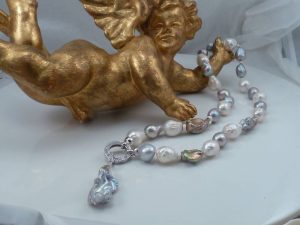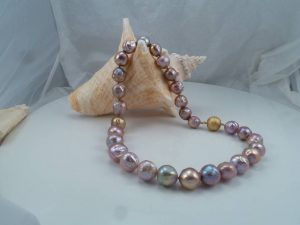
Since the end of the 20th century, the quality of pearls has considerably improved. New varieties have been offered in the jewellery market, including fireball pearls, Chinese Kasumi pearls, and soufflé pearls. It has become possible to find large pearls up to 20 mm (4/5 in.) in diameter with incredible colours—not only white, pink, lavender, or black, but bronze, purple, or golden with greens and blues, many of them displaying colourful iridescence. Pearls may have very high, even metallic, lustre. At the same time, they can be found in a variety of shapes. As a rule, the word ‘pearl’ evokes an image of a small, round orb. Yet, nowadays, there are pearls that have the most unthinkable shapes, including coins, sticks, rosebuds, and even chicken legs. The gems may also have a textured, mottled surface, which contributes to their amazing lustre.
The so-called Chinese Kasumi pearls that appeared in the market about 10 years ago belong to this new pearl generation. These exotic bead-nucleated pearls look like the very expensive and rare freshwater ones that were cultured in Japan’s Lake Kasumigaura in the second half of the 20th century. Due to pollution, Japanese Kasumi pearls are scarce and costly now. Thanks to experimentation and hybridization of the Chinese and Japanese shells, Chinese perliculturists have managed to produce a hybrid mussel to grow similar-looking bead-nucleated freshwater pearls, which cost much less.
These spectacular pearls have different trade names (i.e. Chinese Kasumi pearls, ripple pearls, Ming pearls, or Edison pearls) and are distinguished by bright natural colours, as well as extremely high or metallic lustre and iridescence. The astounding rainbow palette of colours—mauve, blue, and green overtones to gold and silver, pink and bronze, copper and purple, and peach—makes them unforgettable, as do their orient and famous texture.
Moreover, at present, pearl prices are fairly reasonable, and the margins on pearl jewellery may be very good. As customers continue to be price-conscious, it is good to know and to show there is pearl jewellery for different budgets. A customer may choose to wear expensive saltwater pearls, such as white Japanese akoya pearls, white or golden South Sea pearls, or black Tahitian pearls, or they may end up buying freshwater pearls that look gorgeous, but cost a fraction of the price of the saltwater ones. As consumers want a product that has value and, at the same time, is different, fresh, and interesting, the wide price range of pearl jewellery plays an important role.

Given pearls’ diversity, jewellery designers have an astounding material for their creations. It is not surprising nowadays many designers offer fashion-forward, trendy, and even edgy pearl jewellery as well as sophisticated, elegant, and timeless pieces that are always popular and searched for. Some even offer classic, timeless designs with a modern twist. This assortment of pearls and jewellery designs provides retailers with vast opportunities to offer clients. A customer may buy multiple pieces of pearl jewellery, as the choice is no longer limited to a traditional white necklace. Don’t be scared to offer pearls with interesting colours, unusual or whimsical shapes, or rare textures—such pearls always stand out. One of the famous contemporary trends is layering jewellery and mixing pearl necklaces of various lengths, sometimes adding chains to the ensemble to create a very unique, fresh, and modern look.





